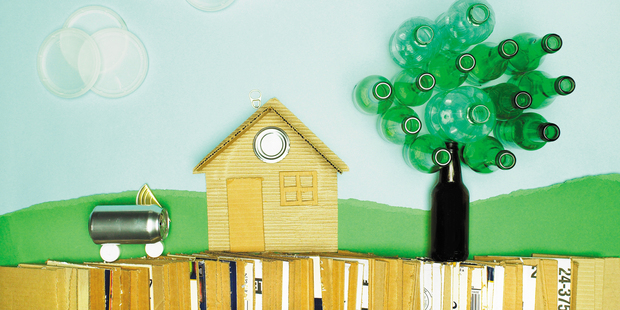New Zealand Herald Article June 2014.
The Ultimate Green Home: Air
Your home can be transformed into a lean, mean machine, making its own power, collecting and storing water, producing no waste and, most importantly, keeping you healthy. Here’s how…
Greening your home can make it healthier, cheaper and more comfortable.
Air quality in New Zealand homes is generally poor, with high rates of asthma and respiratory conditions. Despite our temperate climate, the average indoor temperature is two degrees lower than the 18 degrees recommended by the World Health Organisation. The average human breathes 11,000 litres of air each day, with up to 90 per cent of that indoors.
Moisture
Humidity in the average insulated home is between 65 per cent - 80 per cent, with un-insulated homes over 75 per cent. A damp, cold home is the perfect breeding ground for black mould (stachybotrys), and a warm, moist home will harbour dust mites, which to survive must absorb water from the air.
Use of low VOC (volatile organic compounds) paints and varnishes:
Off-gassing occurs for most materials, and increases as the temperature does.
The most common gas is formaldehyde - a toxin incorporated into a huge number of products. Decreasing the levels of potentially toxic gases is best achieved by using natural materials - such as timber or wool - wherever possible.
Carpets can harbour dust mites and are often the cause of allergies. Wool carpets perform best, but carpet-free floors are best.
Avoid LOSP (light organic solvent based preservative) treated timber as it emits VOC's. Waterborne preservative treatments such as boron are the best option.
Ventilation and filter systems
Super-efficient to run, the systems that bring in fresh air, filter it and push it into your home also serve to drive out moisture and lower the humidity.
It's important to properly vent areas in which moisture are created - such as kitchens, laundry and bathrooms. In the kitchen and bathroom, an effective rangehood and ventilation system will suffice, and in the laundry be sure to vent a clothes dryer directly outside.
Auckland architect Tony Watkins argues that there is no place for a bathroom inside a house, but for most of us that isn't a reality, so extractor fans and open windows are very effective.
Rising damp
Moisture barriers under your home are recommended for homes whose floorboards sit less than half a metre from the ground, or are not well ventilated.
Gas heaters without a flue
These heaters are a recipe for a damp home - the by products of their combustion is water vapour, carbon monoxide and carbon dioxide. Replace with a healthy option. Gas cooking hobs should also be used with extraction systems as well as the above also applies.
For more information on making your home healthier, talk to SAYR today.
The Ultimate Green Home: Air
Your home can be transformed into a lean, mean machine, making its own power, collecting and storing water, producing no waste and, most importantly, keeping you healthy. Here’s how…
Greening your home can make it healthier, cheaper and more comfortable.
Air quality in New Zealand homes is generally poor, with high rates of asthma and respiratory conditions. Despite our temperate climate, the average indoor temperature is two degrees lower than the 18 degrees recommended by the World Health Organisation. The average human breathes 11,000 litres of air each day, with up to 90 per cent of that indoors.
Moisture
Humidity in the average insulated home is between 65 per cent - 80 per cent, with un-insulated homes over 75 per cent. A damp, cold home is the perfect breeding ground for black mould (stachybotrys), and a warm, moist home will harbour dust mites, which to survive must absorb water from the air.
Use of low VOC (volatile organic compounds) paints and varnishes:
Off-gassing occurs for most materials, and increases as the temperature does.
The most common gas is formaldehyde - a toxin incorporated into a huge number of products. Decreasing the levels of potentially toxic gases is best achieved by using natural materials - such as timber or wool - wherever possible.
Carpets can harbour dust mites and are often the cause of allergies. Wool carpets perform best, but carpet-free floors are best.
Avoid LOSP (light organic solvent based preservative) treated timber as it emits VOC's. Waterborne preservative treatments such as boron are the best option.
Ventilation and filter systems
Super-efficient to run, the systems that bring in fresh air, filter it and push it into your home also serve to drive out moisture and lower the humidity.
It's important to properly vent areas in which moisture are created - such as kitchens, laundry and bathrooms. In the kitchen and bathroom, an effective rangehood and ventilation system will suffice, and in the laundry be sure to vent a clothes dryer directly outside.
Auckland architect Tony Watkins argues that there is no place for a bathroom inside a house, but for most of us that isn't a reality, so extractor fans and open windows are very effective.
Rising damp
Moisture barriers under your home are recommended for homes whose floorboards sit less than half a metre from the ground, or are not well ventilated.
Gas heaters without a flue
These heaters are a recipe for a damp home - the by products of their combustion is water vapour, carbon monoxide and carbon dioxide. Replace with a healthy option. Gas cooking hobs should also be used with extraction systems as well as the above also applies.
For more information on making your home healthier, talk to SAYR today.


 RSS Feed
RSS Feed


